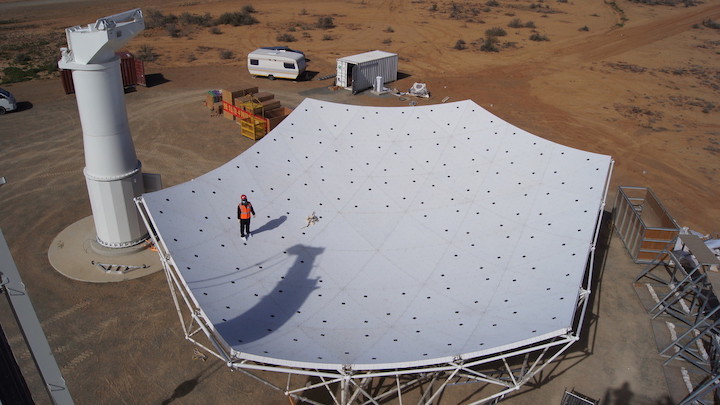19.05.2019
SKA Global Headquarters, 8 May 2019 – The prestigious German research organisation the Max Planck Society has become the 13th member of the SKA Organisation, following a unanimous vote by the SKA Board of Directors at its recent meeting at the SKA Organisation Global Headquarters in the UK.

The Max Planck Society has funded a second SKA prototype dish, SKA-MPI, currently being constructed on site in South Africa, bringing together Chinese, Italian and German components. Credit: SARAO
The Max Planck Society thus joins the final phase of the SKA Organisation, which is overseeing the telescope design phase, until the process of transitioning into the SKA Observatory, an intergovernmental organisation established by treaty to manage the construction and operation of the SKA, is completed. Any further German engagement, through joining the SKA Observatory, remains to be decided and will be subject to future discussions.
“I am delighted to welcome the Max Planck Society to the SKA Organisation as our 13th member, a deserved recognition of the significant contributions Germany has made to the SKA project over the years, and particularly in this crucial pre-construction phase,” said Chairperson of the SKA Board of Directors Dr. Catherine Cesarsky.
German research institutions and industry have been an intrinsic part of SKA-related projects since its earliest days, and have significant involvement in ongoing SKA design activities. In particular, the Max Planck Society provides instrumentation in the form of detectors, data acquisition and analysis systems for South Africa’s world-class MeerKAT telescope, an SKA precursor facility which will become part of SKA’s mid-frequency array (SKA-Mid).
“I am extremely pleased to see our German colleagues consolidating their long-lasting involvement in SKA-related activities both at a scientific and industrial level”, added Prof. Philip Diamond, SKA Director-General. “Germany’s great wealth of expertise in radio astronomy, both in science and engineering, will continue to be invaluable as we move ever closer to SKA construction and operations.”
The Max Planck Society is a non-profit organisation with 84 institutes and research facilities. In collaboration with other German institutions and industry, it has been involved across many areas of SKA design work, including within the Mid Frequency Dish Array, Low Frequency Aperture Array, Central Signal Processor, Science Data Processor, Telescope Manager, Signal and Data Transport consortia, and research and development work within the Phased Array Feeds and Wideband Single Pixel Feeds consortia.
Among the Max Planck Society’s institutes is the Max Planck Institute for Radio Astronomy (MPIfR) a key player in the SKA’s Dish engineering consortium. Together with German industry partners, such as the telescope antenna specialists MT Mechatronics (MTM), and international partners, the Dish consortium is responsible for designing the SKA-Mid, to be deployed in South Africa. The Dish consortium has already delivered two prototype SKA dishes: SKA-P, which is currently being tested in China, and SKA-MPI, funded by the Max Planck Society, which is under construction on the SKA site in South Africa’s Karoo region.
“The SKA is a great opportunity for astronomers, engineers, physicists and data scientists. Besides becoming an amazing discovery machine, SKA pushes the boundaries of what is technically possible, especially in the handling and analysis of huge amounts of data. The Max Planck Society is in the middle of all these exciting science and technology developments, and we are pleased to now be able to contribute officially to the SKAO efforts”, says Prof Michael Kramer, director at the MPIfR.

Together with other German industries MT Mechatronics has developed the prototype elevation drive for the SKA-mid dishes. Credit: MTM
The German science community has a long-held interest in the SKA project even beyond the radio astronomy field, as showcased in the 2012 German White Paper: Pathway to the Square Kilometre Array and in the “Denkschrift 2017: Perspektiven der Astrophysik in Deutschland 2017-2030“, which is the German equivalent to the US Decadal Survey. The German community is also heavily involved in the SKA’s Science Working Groups and Focus Groups and represented the third largest groups of authors in the 2000-page SKA Science Book: Advancing Astrophysics with the Square Kilometre Array, published in 2015.
Germany has decades of experience in radio astronomy and is home to the Effelsberg 100-m Radio Telescope, the world’s second-largest fully steerable radio telescope, located near Bonn. In operation since 1972, the 100-m dish has been continuously upgraded, developing and testing also SKA technology as MPIfR’s flagship telescope. Germany also hosts six Low Frequency Array (LOFAR) stations, an SKA pathfinder facility which stretches across Europe.
About the SKA
The Square Kilometre Array (SKA) project is an international effort to build the world’s largest radio telescope. The SKA is not a single telescope, but a collection of telescopes, called an array, to be spread over long distances. It will be constructed in Australia and South Africa with a later expansion in both countries and into other African countries.
The design has been led by the SKA Organisation based near Manchester, UK and supported by more than 1,000 engineers and scientists in 20 countries. The SKA Organisation is transitioning to the SKA Observatory, an intergovernmental organisation established by treaty, to undertake the construction and operation of the telescope.
The SKA will conduct transformational science and help to address fundamental gaps in our understanding of the Universe including the formation and evolution of galaxies, fundamental physics in extreme environments and the origins of life in the universe.
Quelle: SKA

